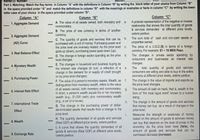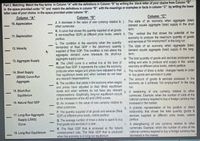
ENGR.ECONOMIC ANALYSIS
14th Edition
ISBN: 9780190931919
Author: NEWNAN
Publisher: Oxford University Press
expand_more
expand_more
format_list_bulleted
Question
Please help me match these words

Transcribed Image Text:Name/.D. Number:
Part 2. Matching: Match the Key terms in Column "A" with the definitions in Column "B" by writing the block letter of your choice from Column "B"
in the space provided under "A" and match the definitions in column "B" with the meanings or examples or facts in column "C" by writing the lower
letter case of your choice in the space provided under column "B".
Section:
Column "A"
Column "B"
Column "C"
A pictorial representation of the negative or inverse
relationship that shows the total quantity of goods
& services demanded at different price levels,
ceteris paribus.
A. The value of all assets owned, both monetary and
nonmonetary.
a.
1. Aggregate Demand
B. The price of one currency in terms of another
2. Aggregate Demand
currency.
b.
The sum total of cash and non-cash assets or
C. The quantity of goods and services that can be
purchased with a unit of money. Purchasing power and
the price level are inversely related: As the price level
goes up (down), purchasing power goes down (up).
D. The change in foreign sector spending as the price d.
level changes.
(AD) Curve
properties owned.
The price of a U.S.D.($) in terms of a foreign
currency. For example: $1 = 16 MXN Peso.
The changes in private sector spending by
consumers and businesses as interest rate
C.
3. Real Balance Effect
changes.
E. The changes in household and business buying as
the interest rate changes (in turn, a reflection of a
change in the demand for or supply of credit brought
on by price level changes).
F. The value of a person's monetary assets. Wealth, as
distinguished from monetary wealth, refers to the value
of all assets owned, both monetary and nonmonetary.
In short, a person's wealth equals his or her monetary
wealth (e.g., $1,000 cash) plus nonmonetary wealth
(e.g., a car or a house).
G. The change in the purchasing power of dollar-
denominated assets that results from a change in the
price level.
4. Monetary Wealth
total quantity of goods and services
consumers are willing and able to buy in the entire
economy at different price levels, ceteris paribus.
The change in the value of imports and exports as
the price level changes.
e.
The
5. Purchasing Power
f.
The amount of cash on hand, that is, wealth in the
g.
form of "the most liquid asset" known to a human
being.
6. Interest Rate Effect
The change in the amount of goods and services
that money can buy as a result of changes in the
price level.
Measures the strength or weakness of money
based on the amount of goods & services money
can buy that depends on the level of prices in the
economy. As the price level rises (falls), the
amount of goods and services that can be
purchased decrease (increase).
h.
7. International Trade
Effect
i.
H. The quantity demanded of all goods and services
(Real GDP) at different price levels, ceteris paribus.
I. A curve that shows the quantity demanded of all
goods & services (Real GDP) at different price levels,
ceteris paribus.
8. Wealth
9. Exchange Rate

Transcribed Image Text:Part 2. Matching: Match the Key terms in Column "A" with the definitions in Column "B" by writing the block letter of your choice from Column "B"
in the space provided under "A" and match the definitions in column "B" with the meanings or examples or facts in column "C" by writing the lower
letter case of your choice in the space provided under column "B".
Column "A"
Column "B"
Column "C"
J. A decrease in the value of one currency relative to j. The state of an economy when aggregate (total)
other currencies.
10. Appreciation
demand equals aggregate (total) supply in the short
term.
K. A curve that shows the quantity supplied of all goods
& services(Real GDP) at different price levels, ceteris k. The vertical line that shows the potential of the
paribus.
L. The condition in the economy when the quantity
demanded of Real GDP = the (short-run) quantity 1. The state of an economy when aggregate (total)
supplied of Real GDP. This condition is met where the
aggregate demand curve intersects the short-run
aggregate supply curve.
11. Depreciation
economy to produce the maximum quantity of goods
and services at "full employment in the long run.
12. Velocity
demand equals aggregate (total) supply in the long-
term.
m. The total quantity of goods and services producers are
willing and able to produce and supply in the entire
economy at different price levels, ceteris paribus.
13. Aggregate Supply
M. The LRAS curve is a vertical line at the level of
Natural Real GDP. It represents the output the economy
produces when wages and prices have adjusted to their n. The number of times a dollar changes hands in order
final equilibrium levels and when workers do not have
any relevant misperceptions.
N. The condition that exists in the economy when wages
and prices have adjusted to their (final) equilibrium
levels and when workers do not have any relevant
misperceptions. Graphically, long-run equilibrium occurs
at the intersection of the AD and LRAS curves.
14. Short Supply
to buy goods and services in a year.
(SRAS) Curve-Run
Aggregate
0. The amount of goods & services produced in the
economy as it achieves "full employment" in the long
run.
p. A weakening of one currency relative to other
currencies. Example: when the number of units of the
national currency required to buy a foreign currency has
increased in the market.
15. Short-Run
Equilibrium
16. Natural Real GDP
O. An increase in the value of one currency relative to
q. A pictorial representation of the positive or direct
relationship that shows the total quantity goods &
services supplied at different price levels, ceteris
paribus.
other currencies.
P. The quantity supplied of all goods and services (Real
GDP) at different price levels, ceteris paribus.
Q. The average number of times a dollar is spent to buy
final goods and services in a year.
R. The Real GDP that is produced at the natural
unemployment rate. The Real GDP that is produced
when the economy is in long-run equilibrium.
17. Long-Run Aggregate
Supply (LRAS)
A strengthening of one currency relative to other
currencies. Example: when the number of units of the
national currency required to buy a foreign currency has
decreased in the market.
Curve
18. Long-Run Equilibrium
4
Expert Solution
This question has been solved!
Explore an expertly crafted, step-by-step solution for a thorough understanding of key concepts.
This is a popular solution
Trending nowThis is a popular solution!
Step by stepSolved in 2 steps

Knowledge Booster
Learn more about
Need a deep-dive on the concept behind this application? Look no further. Learn more about this topic, economics and related others by exploring similar questions and additional content below.Similar questions
Recommended textbooks for you

 Principles of Economics (12th Edition)EconomicsISBN:9780134078779Author:Karl E. Case, Ray C. Fair, Sharon E. OsterPublisher:PEARSON
Principles of Economics (12th Edition)EconomicsISBN:9780134078779Author:Karl E. Case, Ray C. Fair, Sharon E. OsterPublisher:PEARSON Engineering Economy (17th Edition)EconomicsISBN:9780134870069Author:William G. Sullivan, Elin M. Wicks, C. Patrick KoellingPublisher:PEARSON
Engineering Economy (17th Edition)EconomicsISBN:9780134870069Author:William G. Sullivan, Elin M. Wicks, C. Patrick KoellingPublisher:PEARSON Principles of Economics (MindTap Course List)EconomicsISBN:9781305585126Author:N. Gregory MankiwPublisher:Cengage Learning
Principles of Economics (MindTap Course List)EconomicsISBN:9781305585126Author:N. Gregory MankiwPublisher:Cengage Learning Managerial Economics: A Problem Solving ApproachEconomicsISBN:9781337106665Author:Luke M. Froeb, Brian T. McCann, Michael R. Ward, Mike ShorPublisher:Cengage Learning
Managerial Economics: A Problem Solving ApproachEconomicsISBN:9781337106665Author:Luke M. Froeb, Brian T. McCann, Michael R. Ward, Mike ShorPublisher:Cengage Learning Managerial Economics & Business Strategy (Mcgraw-...EconomicsISBN:9781259290619Author:Michael Baye, Jeff PrincePublisher:McGraw-Hill Education
Managerial Economics & Business Strategy (Mcgraw-...EconomicsISBN:9781259290619Author:Michael Baye, Jeff PrincePublisher:McGraw-Hill Education


Principles of Economics (12th Edition)
Economics
ISBN:9780134078779
Author:Karl E. Case, Ray C. Fair, Sharon E. Oster
Publisher:PEARSON

Engineering Economy (17th Edition)
Economics
ISBN:9780134870069
Author:William G. Sullivan, Elin M. Wicks, C. Patrick Koelling
Publisher:PEARSON

Principles of Economics (MindTap Course List)
Economics
ISBN:9781305585126
Author:N. Gregory Mankiw
Publisher:Cengage Learning

Managerial Economics: A Problem Solving Approach
Economics
ISBN:9781337106665
Author:Luke M. Froeb, Brian T. McCann, Michael R. Ward, Mike Shor
Publisher:Cengage Learning

Managerial Economics & Business Strategy (Mcgraw-...
Economics
ISBN:9781259290619
Author:Michael Baye, Jeff Prince
Publisher:McGraw-Hill Education